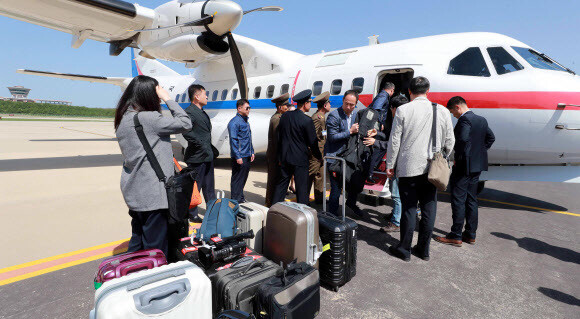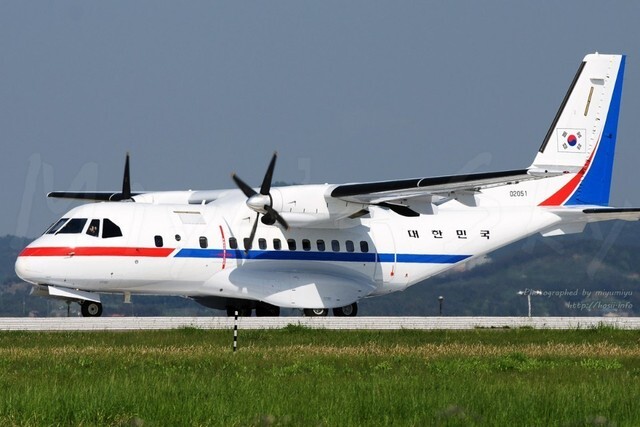hankyoreh
Links to other country sites 다른 나라 사이트 링크
Back channels between NIS and UFD purportedly kicked in to resolve issues

Inter-Korean relations received a green light to resume on May 23, a week after the yellow signal sent with North Korea’s May 16 postponement of schedule high-level talks.
The first practical step came when South Korean reporters belatedly joined the foreign press on the ground for the North’s closure of its “northern nuclear testing site” at Punggye Village in Kilju County, North Hamgyong Province. The official announcement came just after a Washington summit on May 22 between South Korean President Moon Jae-in and US President Donald Trump.
It signaled the resumption of President Moon and North Korean leader Kim Jong-un’s cooperation toward the success of an upcoming North Korea-US summit in Singapore on June 12 – while offering proof that the recent situation on the Korean Peninsula is governed by a trigonometric function involving South and North Korea and the US.
Of particular importance here is President Moon’s prediction during his summit with Trump that a resumption in high-level inter-Korean talks and other dialogue would come “after May 25, which is the ending date for the Max Thunder joint South Korea-US military exercises that North Korea has condemned,” according to Blue House Senior Secretary for Public Relations Yoon Young-chan.
His singling out of May 25 as a date was noteworthy: it sent the message that Seoul and Pyongyang have resumed progress toward honoring President Moon and Kim’s promise in Article 1-1 of their Apr. 27 Panmunjeom Declaration to “bring forth the watershed moment for the improvement of inter-Korean relations,” and carried the implication that the two sides have already reached some agreement in that regard.
The key driving force in this sudden shift in inter-Korean relations over the space of a week was the back channel established between the South’s National Intelligence Service (NIS) and the North’s United Front Department (UFD), sources said. After Pyongyang “refused” a list of South Korean reporters to visit Punggye Village on May 18, the NIS and UFD reportedly went to work frantically behind the scenes around May 21. That situation was reflected in a senior Blue House officials’ report that President Moon may have based his related remarks on “various analyses.”
Various sources closely acquainted with the process reported that the two sides remained at odds initially before the afternoon of May 22, when they began making swift progress. That same day, Won Jong-hyok, the Rodong Sinmun’s Beijing correspondent, predicted, “If you wait until tomorrow [May 23], there may be some good news” – a tiny surface ripple hinting at progress in the talks behind the scenes.
The importance of the South Korean press’s coverage of the “northern nuclear test site” closure goes beyond inter-Korean relations. It was also a way of honoring the South and North Korean leaders’ agreement and their “common goal” of “complete denuclearization” and “a nuclear-free Korean Peninsula.”
“The symbolic importance of the South Korean reporters’ coverage on the ground at Punggye Village is great, since it means the North is acknowledging the South as an agent in the denuclearization process,” a senior foreign affairs and national security figure said.

How will inter-Korean relations continue to improve once the Max Thunder exercises finish on May 25? President Moon referred to a “resumption of high-level talks and other dialogue.” One immediate step would be the resumption of the high-level inter-Korean talks postponed after the two sides agreed to hold them on May 16.
Instead of high-level talks, they could also get dialogue started again by holding general-level military talks as the leaders agreed to do “in May” in the Panmunjeom Declaration. Inter-Korean athletic talks for the Asian Games in August carry little political baggage and some sense of urgency.
“In terms of what channels South and North will use for dialogue, we will need to each conduct internal reviews and discuss the matter some more,” a senior official said.
By Lee Je-hun, senior staff writer
Please direct comments or questions to [english@hani.co.kr]

Editorial・opinion
![[Column] Season 2 of special prosecutor probe may be coming to Korea soon [Column] Season 2 of special prosecutor probe may be coming to Korea soon](https://flexible.img.hani.co.kr/flexible/normal/500/300/imgdb/original/2024/0426/3317141030699447.jpg) [Column] Season 2 of special prosecutor probe may be coming to Korea soon
[Column] Season 2 of special prosecutor probe may be coming to Korea soon![[Column] Park Geun-hye déjà vu in Yoon Suk-yeol [Column] Park Geun-hye déjà vu in Yoon Suk-yeol](https://flexible.img.hani.co.kr/flexible/normal/500/300/imgdb/original/2024/0424/651713945113788.jpg) [Column] Park Geun-hye déjà vu in Yoon Suk-yeol
[Column] Park Geun-hye déjà vu in Yoon Suk-yeol- [Editorial] New weight of N. Korea’s nuclear threats makes dialogue all the more urgent
- [Guest essay] The real reason Korea’s new right wants to dub Rhee a founding father
- [Column] ‘Choson’: Is it time we start referring to N. Korea in its own terms?
- [Editorial] Japan’s rewriting of history with Korea has gone too far
- [Column] The president’s questionable capacity for dialogue
- [Column] Are chaebol firms just pizza pies for families to divvy up as they please?
- [Column] Has Korea, too, crossed the Rubicon on China?
- [Correspondent’s column] In Japan’s alliance with US, echoes of its past alliances with UK
Most viewed articles
- 1No good, very bad game for Korea puts it out of Olympics for first time since 1988
- 2Division commander ordered troops to enter raging flood waters before Marine died, survivor says
- 3Korea’s 1.3% growth in Q1 signals ‘textbook’ return to growth, says government
- 4Will NewJeans end up collateral damage in internal feud at K-pop juggernaut Hybe?
- 5[Column] Season 2 of special prosecutor probe may be coming to Korea soon
- 6[Editorial] Korea’s surprise Q1 growth requires objective assessment, not blind fanfare
- 7[Column] ‘Choson’: Is it time we start referring to N. Korea in its own terms?
- 8‘We must say no’: Seoul defense chief on Korean, USFK involvement in hypothetical Taiwan crisis
- 9Korea sees more deaths than births for 52nd consecutive month in February
- 10Is N. Korea threatening to test nukes in response to possible new US-led sanctions body?